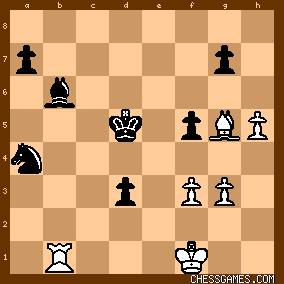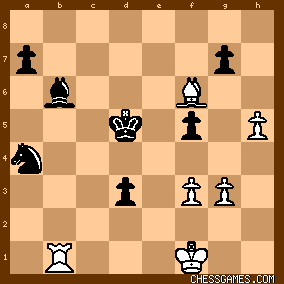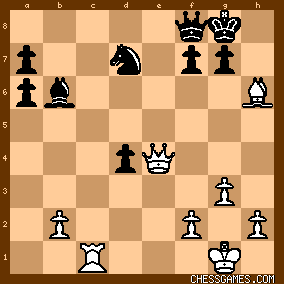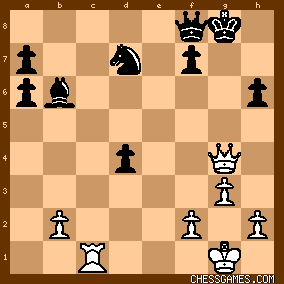| Mar-23-04 | | Benjamin Lau: 9...d4?! is ironic in a weird way since Lasker's 9. Nbd2 had been deliberately chosen to place strong pressure on the d4 square after an Nb3. Tarrasch eventually cedes the bishop pair in an open position to keep the pawn but Lasker drags him down with tactics. |
|
| Mar-23-04 | | drukenknight: 35...Ne4 w/ idea of advancing d3 looks better. |
|
| Jan-25-05 | | e4Newman: Although he goes on to lose the game, Tarrasch is quoted as saying (of 3...e6), "This I hold to be the best, although I must add that I am almost completely alone in holding that opinion. It is based upon the undeniably correct idea that in the Queen's Gambit ...P-QB4 is the freeing move for Black..." While I agree about the merit of that move, there are ways to add to that and create even greater complications for white. Perhaps Magnus Carlsen lives by Tarrasch's motto "He who fears an isolated Queen's pawn should quit chess." |
|
Nov-15-05
 | | keypusher: "A beautifully played game, but then almost all of Lasker's games in this Tournament are worthy of a World Champion." A generous (though accurate!) tribute from Tarrasch. |
|
| Nov-15-05 | | Calli: 41...Ne6 would keep Black in the game a while longer. Some good moves on both sides and the usual excellent notes by Tarrasch. |
|
| Nov-15-05 | | ughaibu: The note to move 15 is odd, wouldn't a6 lose the bishop? |
|
| Nov-16-05 | | Calli: Bad translation, I think - probably Bc5 AND a6 to stop the pawn. |
|
| Nov-16-05 | | iron maiden: The typo (if it is one, otherwise this is one of the greatest annotation errors of all time) exists in the original notes from the tournament book as well. |
|
| Nov-16-05 | | sneaky pete: Not in the "original" (that is German) <original notes from the tournament book>. "... also hier oder wenigstens im nächsten Zuge Lc5 und a7-a6 zu spielen." <und> (and) has been translated as <or> and the <either> bit has been added by the translator. |
|
| Nov-16-05 | | Calli: <sneaky pete> Thanks for looking it up and confirming my suspicions. CG is great for stuff like this. And what kind of translator gets "oder" and "und" mixed up in that sentence. Sehr schlecht! |
|
| Nov-21-05 | | Petrocephalon: <Keypusher> Being a fan of Tarrasch, I was gratified and relieved to read him being as generous to another as he sometimes was to himself! |
|
| Nov-22-05 | | Petrocephalon: Replete with petit combinaisons, in addition to the grand combination. |
|
Feb-23-07
 | | tpstar: 1. d4 d5 2. Nf3 c5 3. c4 e6 <The Tarrasch Defense to the Queen's Gambit, where Black accepts an IQP [D02]> 4. cxd5 exd5 5. g3 <White plans to fianchetto the KB> Nc6 6. Bg2 Nf6 7. 0-0 Be7 8. dxc5 <White makes Black waste a move> Bxc5 9. Nbd2 d4 10. Nb3 <Attacking the Bc5 and the Pd4, also freeing the diagonal for White's QB> Bb6 11. Qd3 <Develops the Queen while blockading the IQP> Be6 12. Rd1 <White pressures the Pd4> Bxb3 13. Qxb3 Qe7 14. Bd2 0-0 <14 ... Qxe2?? 15. Re1> 15. a4 Ne4 <15 ... Qxe2 16. a5 (not 16. Re1 Qa6) Bc5 17. Qxb7 and White is more active> 16. Be1 Rad8 <[last book move]<>> 17. a5 Bc5 18. a6 bxa6 19. Rac1 <Interesting that White plays 17. a5 & 18. a6 to disrupt Black's Queenside, but then avoids 19. Rxa6 in favor of 19. Rac1 pressuring the minor pieces on the c file> Rc8 20. Nh4 <White sets a trap based on an extended Knight fork> Bb6? <[20 ... Ng5  ]<>> 21. Nf5 Qe5 22. Bxe4 <[22. Qf3!? Nf6 23. Qf4 Qxf4 24. gxf4 ]<>> 21. Nf5 Qe5 22. Bxe4 <[22. Qf3!? Nf6 23. Qf4 Qxf4 24. gxf4  ]<>> Qxe4 23. Nd6 <White wins the exchange, so Black grabs a Pawn> Qxe2 24. Nxc8 Rxc8 25. Qd5 Qe6 26. Qf3 <White declines to trade Queens> <[26. Qxe6 fxe6 27. f4 ]<>> Qxe4 23. Nd6 <White wins the exchange, so Black grabs a Pawn> Qxe2 24. Nxc8 Rxc8 25. Qd5 Qe6 26. Qf3 <White declines to trade Queens> <[26. Qxe6 fxe6 27. f4  ]<>> h6 27. Bd2 Ne5 28. Rxc8+ Qxc8 29. Qe4 Nd7 <[29 ... f6!? =]<>> 30. Rc1 Qf8 31. Bxh6! Nc5 <31 ... gxh6 32. Qg4+ & 33. Qxd7> 32. Qg4 f5 33. Qg6 Qf7 34. Qxf7+ Kxf7 35. Bg5 Nd3 <[35 ... Ne4 36. f4 =]<>> 36. Rb1 <White protects the important Pb2> Ke6 37. b3 Kd5 <Black centralizes the King for the endgame, yet there's an upcoming tactic involving the undefended Kingside Pawns. So Black should aim to trade off all the Pawns and draw, but leave the King on e6 for now.> 38. f3 a5 39. h4 Nc5 40. h5 d3 <[40 ... a4 41. bxa4 Nxa4 42. Kf1 ]<>> h6 27. Bd2 Ne5 28. Rxc8+ Qxc8 29. Qe4 Nd7 <[29 ... f6!? =]<>> 30. Rc1 Qf8 31. Bxh6! Nc5 <31 ... gxh6 32. Qg4+ & 33. Qxd7> 32. Qg4 f5 33. Qg6 Qf7 34. Qxf7+ Kxf7 35. Bg5 Nd3 <[35 ... Ne4 36. f4 =]<>> 36. Rb1 <White protects the important Pb2> Ke6 37. b3 Kd5 <Black centralizes the King for the endgame, yet there's an upcoming tactic involving the undefended Kingside Pawns. So Black should aim to trade off all the Pawns and draw, but leave the King on e6 for now.> 38. f3 a5 39. h4 Nc5 40. h5 d3 <[40 ... a4 41. bxa4 Nxa4 42. Kf1  ]<>> 41. Kf1 <White's King needs to blockade the passed d Pawn - 41. Kf2? Ne4+ & 42 ... Nxg5> a4 <[41 ... Ne6 42. h6 gxh6 43. Bxh6 ]<>> 41. Kf1 <White's King needs to blockade the passed d Pawn - 41. Kf2? Ne4+ & 42 ... Nxg5> a4 <[41 ... Ne6 42. h6 gxh6 43. Bxh6  ]<>> 42. bxa4 Nxa4?! <[42 ... Kc4 43. Rc1+ Kd5 ]<>> 42. bxa4 Nxa4?! <[42 ... Kc4 43. Rc1+ Kd5  ]<>> 43. Bf6! Ke6 <43 ... gxf6 44. h6 and the Pawn Queens> 44. Bxg7 Kf7 45. Be5 <White centralizes the Bishop over 45. h6 Kg6 and the Bg7 must protect the Ph6> Nc5 46. Rd1 1-0. ]<>> 43. Bf6! Ke6 <43 ... gxf6 44. h6 and the Pawn Queens> 44. Bxg7 Kf7 45. Be5 <White centralizes the Bishop over 45. h6 Kg6 and the Bg7 must protect the Ph6> Nc5 46. Rd1 1-0.<[Fritz 7]<>> |
|
| Mar-29-09 | | notyetagm: Lasker vs Tarrasch, 1914 43 ?

click for larger view43 ♗g5-f6!

click for larger view |
|
| Sep-05-09 | | WhiteRook48: under grounds of 43...gxf6 44 h6 |
|
| Oct-08-09 | | Ulhumbrus: An alternative to 27...Ne5 is 27...Ne7 so that in the event of Qe4, the N does not have to go to d7 allowing the potential fork Qg4+ after Bxh6. On 27..Ne7 28 Rxc8 Qxc8 29 Qe4 Qd7 White does not have the fork 30 Bxh6 gxh6 31 Qg4+, as he does with the N on d7 |
|
| Sep-05-10 | | notyetagm: Lasker vs Tarrasch, 1914 31 ?

click for larger view31 ♗d2xh6!

click for larger viewGame Collection: Enemy king makes great target for double attack Lasker vs Tarrasch, 1914 31 Bd2xh6! seeks to target Black g8-king in addition d7-knight |
|
| Jun-12-11 | | AnnKittenplan: Playing through Chernev's Instructive Games. This game, #18, is characterised as exploitation of a weakened IP, but it seems to hinge on two tactics: firstly the oversight leading to 31. Bxh6 and secondly, maybe to a lesser extent, 43. Bf6. Was Black already lost as Tarrasch claims in his annotations. Of course this could have been cracking under relentless positional pressure but playing through the game Black has chances throughout based on his passer, he just seems to misstep at a couple of crucial points.
Looking back, the first comment about big tactics and little tactics sums it up nicely. |
|
| Jan-03-12 | | notyetagm: Game Collection: JOSEKI: ENEMY KING MAKES A GREAT SECOND TARGET |
|
| Jan-03-12 | | notyetagm: Game Collection: JOSEKI: ENEMY KING MAKES A GREAT SECOND TARGET
click for larger view |
|
| May-26-12 | | bystander: 24 ♘c8x? Why not 24 ♖d2 first? After a black queen move, white can double the rooks on the c-file, putting a lot of pressure on ♘c6. E.g. 24 ♖d2 ♕e7 25 ♘c8x ♖c8x 26 ♖dc2. |
|
| Oct-20-18 | | Howard: Nunn's book on Lasker gives no less than three places where Lasker could have wrapped up the game quicker. Frankly, it's yet another example of Chernev's entertaining, but superficial analysis, in TMIGOCEP. |
|
| Apr-03-25 | | Mathematicar: 18...b6!? 19.Qa4 Rc8 20.Nd2! |
|





































